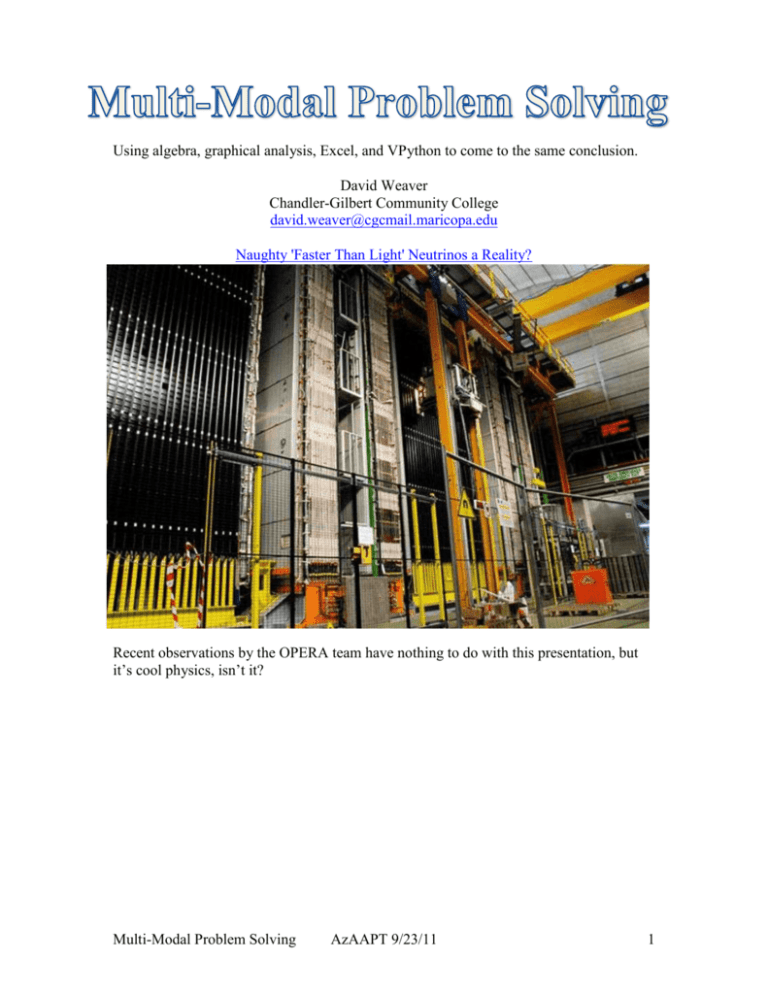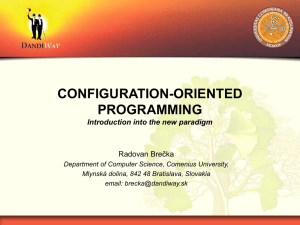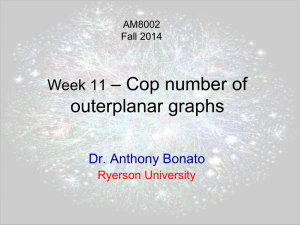Multi-Modal Problem Solving
advertisement

Using algebra, graphical analysis, Excel, and VPython to come to the same conclusion. David Weaver Chandler-Gilbert Community College david.weaver@cgcmail.maricopa.edu Naughty 'Faster Than Light' Neutrinos a Reality? Recent observations by the OPERA team have nothing to do with this presentation, but it’s cool physics, isn’t it? Multi-Modal Problem Solving AzAAPT 9/23/11 1 .. .. .. .. .. Introduction Model building in physics Physicists don’t study the real world. Physicists build models of the physical world, and then study these models in the hopes of gaining insight into how the world operates. Therefore, what you will do throughout this course is build models, of increasing complexity, of the real world and by closely examining these models you may gain insight into how the world operates. Some of the early models you will examine will be obviously limited, but keep in mind that even the most advanced physicists are merely model-builders, and the models they study are as obviously superficial to them as the models we will study are to us. Model building is necessary because of the overwhelming complexity of the real world. To attempt to study a real phenomenon, with all of its many details intact, is extremely difficult. Moreover, models often allow you to focus on the important aspects of a phenomenon, without the distracting details. For example, a model of reality that everyone is familiar with is the road map. Imagine trying to drive to a strange address across town using a road map that included every driveway and alleyway! Although these details do exist, a model that tried to encompass all of these details would be less useful than one in which everyone’s driveway was omitted. Thus, it is possible to omit detail, to be a poorer reflection of reality, yet to be a better, more effective, and more useful model. A useful model for driving across town would ignore driveways but probably include most, if not all, streets. However, if your task was to drive across the state, not only should the driveways be omitted, but so should the vast majority of side streets; probably state and federal highways should be the only roads on the map. Thus, a good model is closely tied to the task at hand. What can be a very useful model for one task can be useless for another. Thus, when we build models where the effects of friction are neglected, or the shape of an object is ignored, it is not the case that this is a deficient model of the situation. It may well be the case that if these details were included, some important features of the scenario would be masked by the complexity. Simplifications made in constructing models of reality are not always limitations to the usefulness of the model, often they are the key to building a useful and productive model. From Spiral Physics by Paul D’Alessandris Multi-Modal Problem Solving AzAAPT 9/23/11 2 A pole-vaulter, just before touching the cushion on which she lands after a jump, is falling downward at a speed of 10 m/s. The pole-vaulter sinks about 2.0 m into the cushion before stopping. The problem begins when she hits the cushion, not Motion Diagram Motion Information while she’s falling through the air. The top of the cushion Event 1: The instant she is the origin. strikes the cushion. a Event 2: The instant she stops. t1 = 0 s t2 = r1 = 0 m r2 = -2.0 m v1 = -10 m/s v2 = 0 m/s She stops below the origin. a12 = She’s initially moving downward, which was chosen as the negative direction. Mathematical Analysis v2 = v1 + a12 (t 2 - t1 ) 1 r2 = r1 + v1 (t2 - t1 ) + a12 (t2 - t1 )2 2 æ mö m 1 ç 10 ÷ -2m = 0 -10 (t2 - 0) + ç s ÷ (t2 - 0)2 s 2 t2 çè ÷ø m + a12 (t 2 - 0) s m 10 s a12 = t2 0 = -10 Now substitute this expression into the other equation: Substitute this result back into the original equation: m s a12 = 0.4s m/s a12 = 25 s 10 Multi-Modal Problem Solving æ mö 5 m ç ÷ -2m = -10 t2 + ç s ÷ t22 s t çè 2 ÷ø m m t 2 + 5 t2 s s m -2m = -5 t2 s -2m t2 = m -5 s t2 = 0.4s -2m = -10 AzAAPT 9/23/11 3 The driver of a car traveling at 16 m/s sees a truck 20 m ahead traveling at a constant speed of 12 m/s. The car starts without delay to accelerate at 4.0 m/s2 in an attempt to rear-end the truck. The truck driver is too busy talking on his cellular phone to notice the car. Motion Diagram Car Truck Motion Information Object: Car Object: Truck Event 1: Car begins to accelerate. Event 2: Collision! Event 1: Car begins to accelerate. Event 2: Collision! t1 = 0 s t2 = t1 = 0 s t2 = r1 = 0 m r2 = r1 = 20 m r2 = v1 = 16 m/s v2 = v1 = 12 m/s v2 = a12 = +4 m/s2 a12 = 0 m/s2 Mathematical Analysis At first glance, there appear to be six unknowns in the motion table. This should concern you since you only have four equations (the two kinematic equations applied to the car and the same two applied to the truck). However, since the car and truck collide at event 2, t2 and r2 for the car and truck must be equal at this event. Thus, the only four variables are t2, r2, v2Car, and v2Truck. These can be determined by the four kinematic equations. Specifically, set the position equation for the car equal to the position equation for the truck and solve for t2: r2Car = r2Truck 0 + 16 m 1 m/s m 1 (t 2 - 0) + (4 )(t 2 - 0)2 = 20m + 12 (t 2 - 0) + (0)(t 2 - 0)2 s 2 s s 2 m m/s 2 m 16 t 2 + 2 t 2 = 20m + 12 t 2 s s s m m/s 2 0 = 20m - 4 t 2 - 2 t2 s s Using the quadratic formula, t2 = 2.32 s. Plugging this back into either position equation yields, r2Car = 0 + 16 m 1 m/s (2.32s - 0) + (4 )(2.32s - 0)2 s 2 s r2Car = 47.9m Solving the two velocity equations gives: m m/s +4 (2.32s) s s = 25.3m / s m m/s +0 (2.32s) s s = 12m / s v2Car = 16 v2Truck = 12 v2Car v2Truck Multi-Modal Problem Solving AzAAPT 9/23/11 4 A car speeds through a school zone, traveling at 20 m/s. It takes the police officer 5 s to secure the RADAR gun and start her motorcycle. She accelerates at 5 m/s/s until she catches up to the clueless speeder. Motion Diagram Motion Information Object: Object: Event 1: Event 2: Event 1: Event 2: t1 = t2 = t1 = t2 = r1 = r2 = r1 = r2 = v1 = v2 = v1 = v2 = a12 = a12 = Mathematical Analysis http://goo.gl/Zhesy Multi-Modal Problem Solving AzAAPT 9/23/11 5 A car speeds through a school zone, traveling at 20 m/s. It takes the police officer 5 s to secure the RADAR gun and start her motorcycle. She accelerates at 5 m/s/s until she catches up to the clueless speeder. http://goo.gl/YvO0m Multi-Modal Problem Solving AzAAPT 9/23/11 6 t (s) Rp (m) Vp (m/s) 0 0 1 "=B2+C3*1" 2 3 4 5 6 7 8 9 10 11 12 13 14 15 16 17 t (s) Rp (m) 0 1 2 3 4 5 6 7 8 9 10 11 12 13 14 15 16 Rc (m) Vc (m/s) 20 0 0 20 0 0 20 0 0 20 0 0 20 0 0 20 0 0 20 "=D7+E8*1" "=E7+F8*1" 20 20 20 20 20 20 20 20 20 20 20 Vp (m/s) 0 20 40 60 80 100 120 140 160 180 200 220 240 260 280 300 320 Multi-Modal Problem Solving Rc (m) 20 20 20 20 20 20 20 20 20 20 20 20 20 20 20 20 20 Vc (m/s) 0 0 0 0 0 0 5 15 30 50 75 105 140 180 225 275 330 AzAAPT 9/23/11 Ac (m/s/s) 0 0 0 0 0 0 5 5 5 5 5 5 5 5 5 5 5 5 Ac (m/s/s) 0 0 0 0 0 0 5 10 15 20 25 30 35 40 45 50 55 0 0 0 0 0 0 5 5 5 5 5 5 5 5 5 5 5 7 t Vp Ac (s) Rp (m) (m/s) Rc (m) Vc (m/s) (m/s/s) 0 0 20 0 0 1 "=B2+C3*1" 20 0 0 2 20 0 0 3 20 0 0 4 20 0 0 5 20 0 0 6 20 "=D7+E8*1" "=E7+(F7+F8)/2*1" 7 20 8 20 9 20 10 20 11 20 12 20 13 20 14 20 15 20 16 20 17 20 t (s) Rp (m) 0 1 2 3 4 5 6 7 8 9 10 11 12 13 14 15 16 17 Vp (m/s) 0 20 40 60 80 100 120 140 160 180 200 220 240 260 280 300 320 340 Multi-Modal Problem Solving Rc (m) 20 20 20 20 20 20 20 20 20 20 20 20 20 20 20 20 20 20 0 0 0 0 0 0 2.5 10 22.5 40 62.5 90 122.5 160 202.5 250 302.5 360 AzAAPT 9/23/11 Vc (m/s) 0 0 0 0 0 0 5 10 15 20 25 30 35 40 45 50 55 60 0 0 0 0 0 0 5 5 5 5 5 5 5 5 5 5 5 5 Ac (m/s/s) 0 0 0 0 0 0 5 5 5 5 5 5 5 5 5 5 5 5 8 ## Cop N Perp by David Weaver ## BIG help from Danny Caballero of Georgia Tech ## Perp passes a cop in a school zone, traveling 20 m/s ## Cop takes off 5 s later, accelerating at 5 m/s/s from visual import * ## includes the visual module scene = display(forward=(0,-.7,-1)) # Tilts the camera for more of a bird's eye view scene.fullscreen = True # Expands the window to fill your screen ## Objects in scene ground = box(pos=vector(0,-20,0), axis=(350,0,0), width=50, color=color.green) perp = sphere(pos=vector(-175,2,0), radius=20, color=color.red) cop = sphere(pos=vector(-175,2,10), radius=20, color=color.blue) ## Initial conditions perp.v = vector(20,0,0) ## Perp's velocity is 20 m/s in x-direction cop.v = vector(0,0,0) ## Cop starts from rest. ## Trails to track ball's path (not needed, but kinda cool) perptrail = curve(color=perp.color) coptrail = curve(color=cop.color) ## Assign acceleration a=vector(5,0,0) ## Cop accelerates at 5 m/s/s ## Start the clock dt = 0.001 ## This is the time step t=0 while t < 16.5: ## I got this value from the Excel spreadsheet rate(3000) ## Adjusts how fast the simulation runs. perp.pos = perp.pos + perp.v*dt ##Xf = Xi + V*t if t>5: ## Cop takes 5 s to get started cop.v = cop.v+a*dt ## Vf = Vi + a*t cop.pos = cop.pos + cop.v*dt ## Xf = Xi + V*t ## Update the trail to track position perptrail.append(perp.pos) coptrail.append(cop.pos) t=t+dt ## Increments time ## Range & velocity calculations (all balls starting from (-175,2,0)) change if you need to R1 = perp.pos.x - (-175) R2 = cop.pos.x - (-175) V1 = perp.v V2 = cop.v print ("Time", t, "s") print ("Perp's range:", R1, "m") print ("Cop's range:", R2, "m") print ("Perp's velocity", V1, "m/s") print ("Cop's velocity", V2, "m/s") Multi-Modal Problem Solving AzAAPT 9/23/11 9



